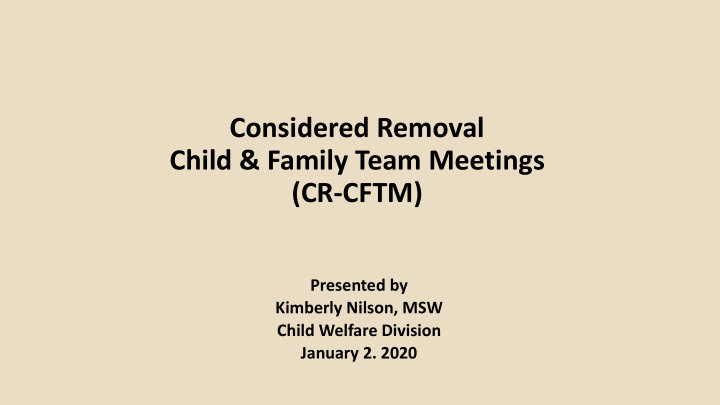



Considered Removal Child & Family Team Meetings (CR-CFTM) Presented by Kimberly Nilson, MSW Child Welfare Division January 2. 2020
CR-CFTM: Overview Implemented CR-CFTM in February 2013, as part of our teaming continuum. Purpose of CR-CFTMs: • Mitigate safety factors to prevent removal by identifying and utilizing family’s natural/formal supports; • Address risk factors that impact child safety; • Engage families and their supports in safety planning and placement-related decisions; • Identify roles/responsibilities of team members and together strategies are developed to help keep child safe; and • Explore and identify extended family & kin as potential placement resources for child should removal be necessary
CR-CFTM Overview Considered Removal Meetings are required when a child is being considered for immediate removal based on the identification of a safety factor. Utilizes Structured Decision-Making (SDM) Safety Assessment Tool to inform removal decision. Meetings are run by an independent trained facilitator, outside chain of command. Six Stages of CR Meeting: Introduction, Identify the Situation/Problem, Assess the Situation, Develop Ideas, Reach a Decision, Recap/Close.
Key Practice Elements Meetings are held prior to removal of a child from the home unless the family situation requires an emergency removal to ensure child safety. If a child has been removed, a meeting will occur within two business days, prior to the filing of a Motion for Order of Temporary Custody. The focus of the meeting is on child safety and results in a “live” decision regarding a child's removal from the home. • DCF will make the decision if consensus cannot be reached during the meeting. Meeting participants include parents/guardians, child/youth, extended family, natural supports, service providers & DCF staff. Meetings help to identify the family's strengths, resources and protective capacities
CR-CFTM Data since implementation This year, 79.5% of meetings occurred prior to the child’s removal, consistent from the Considered Removal - Child/Family Team Meetings (CR-CFTM) 3500 prior year. 2980 2558 3099 3000 2729 2309 Since 2014, 13,272 child- 2611 2500 2359 specific meetings have 1884 2168 1631 1714 occurred, 76% occurred 1870 2000 1798 prior to removal. 1623 1572 1550 1500 674 1028 940 1000 741 740 671 610 567 561 451 500 331 116 0 # Child-Specific Meetings # Families With Meetings # Meetings Held Prior to Entry # Meetings Held After Entry 2013* 2014 2015 2016 2017 2018 2019* *Represents partial FY. Data thru 5.7.19
Father Participation in CR-CFTMs by FY Since 2016, fathers 70.0% have participated in 60.0% 58.1% 55.5% 60.0% 54.5% 57% of the CR Meetings held either 50.0% in-person or by 40.0% phone. 30.0% Engaging fathers continues to be an 20.0% area of challenge and 10.0% is one of our PIP priorities. 0.0% 2016 2017 2018 2019* * Represents data thru 10.7.19
*Represents partial FY. Data thru 5.7.19 CR-CFTM Decision for Meetings Held Prior Placement Recommendations Of CR-CFTM Held Prior to Recommended Placement Type for CR-CFTM Held Prior to Entry Entry 100% 100% 19.0% 21.0% 28.2%, 27.8%, 28.7%, 26.9% 26.8% 29.7% 30.2% 31.9% 35.4%, 36.7%, 39.0%, 207 69 155 237 182 75% 76 75% 50% 50% 81.0% 79.0% 73.2% 73.1% 70.3% 69.8% 68.1% 71.8%, 72.2%, 71.3%, 64.6%, 63.3%, 25% 61.0%, 179 527 386 433 314 119 25% 0% 2013* 2014 2015 2016 2017 2018 2019* 0% % Placement Recommended 2014 2015 2016 2017 2018 2019* % Placement Not Recommended Kinship Care Foster/Congregate Care This chart represents CR meetings held prior to removal since 2014 and This chart represents Considered Removal (CR) Meetings held prior to depicts the recommended placement for those children who were removal and the recommended outcome of the meeting. The data recommended for removal. Kinship care continues to be the primary demonstrates the Department’s ability to engage in safety planning placement recommended for children who are the subject of a CR meeting. efforts with families. This past year 70% of children were not This year, 72% of children were recommended for placement in kinship care. recommended for removal, a decrease from the prior year (73%).
This chart reflects the CR meetings Rate of Diversion & Entry into Care by CR Recommendation held prior to the child’s removal and compares the recommendation of 120.0% the meeting (removal) and whether 100.0% the child actually entered care. 80.0% For this year, 93% of the children 60.0% with a recommendation to remove, 40.0% entered care, a slight decrease from prior year (95%). This has been fairly 20.0% consistent since implementation. 0.0% 2014 2015 2016 2017 2018 2019* Since 2014, there has been a decline Of All Meetings Prior to Entry Diverted Of All Meetings Prior to Entry Entered in the percentage of children who Placement Not Recommended Diverted Placement Not Recommended Entered entered care but removal was not Placement Recommended Diverted Placement Recommended Entered recommended, from 45% in 2016 to 20% in 2019. Of Meetings Prior to Entry 2014 2015 2016 2017 2018 2019* Of All Meetings Prior to Entry Diverted 44.3% 45.5% 47.1% 54.0% 55.8% 58.1% Overall , the “live decision” made at Entered 55.7% 54.5% 52.9% 46.0% 44.2% 41.9% the meeting appears fairly Placement Not Recommended Diverted 54.6% 61.1% 65.8% 74.6% 74.5% 80.0% consistent with what happens after Entered 45.4% 38.9% 34.2% 25.4% 25.5% 20.0% the meeting. Placement Recommended Diverted 5.6% 3.2% 7.2% 5.2% 4.7% 7.4% Entered 94.4% 96.8% 92.8% 94.8% 95.3% 92.6% *Represents partial FY. Data thru 5.7.19
CR-CFTM – Key Takeaways • Since implementation, meetings have consistently occurred prior to a child’s removal • Removal not recommended has been the predominate outcome of the CR meeting • For those recommended for removal, placement with relatives/kin continues to be the primary placement recommended • Removal recommendation and entry into care has been fairly consistent; the recommended placement made during the meeting and actual placement setting for child is also consistent
Recommend
More recommend